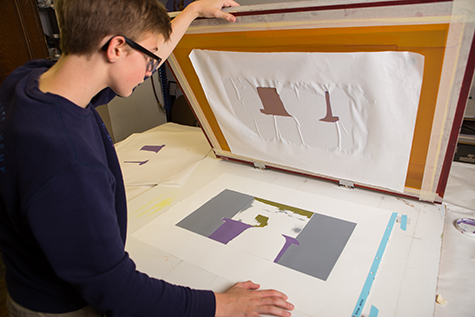ChatGPT said: What customers are saying in 10:9 Design reviews: real experiences
Wiki Article
The Crucial Overview to Understanding Screen Printing and Its Versatile Makes use of
Screen printing has an abundant background that goes back to ancient times, advancing right into an advanced method utilized throughout numerous markets today. This overview discovers the ins and outs of the screen printing process, detailing its applications in home, style, and marketing decoration - 10:9 Design Abilene. Understanding these principles can open up creative possibility for both business and artistic projects. The following areas will certainly expose crucial pointers and methods to improve one's screen printing endeavorsThe History of Screen Printing
Although screen printing has origins that map back centuries, its development reflects the imaginative and technical improvements of various cultures. Originating in old China, the technique was at first used for decorating fabrics and later spread to Japan, where it ended up being indispensable to Ukiyo-e woodblock printing. The method moved to Europe in the 18th century, where it acquired appeal amongst craftsmens and commercial printers. The innovation of picture solution in the 20th century changed screen printing, enabling more detailed styles and greater effectiveness. Musicians like Andy Warhol better moved its popularity, using the medium to develop iconic works that blended commercialism and great art. By the late 20th century, screen printing had actually established itself as a functional technique, employed in vogue, advertising, and great art. Today, it continues to advance, integrating digital innovation and expanding its applications across different sectors.The Screen Printing Process Explained
Screen printing transforms imaginative visions right into tangible designs with a series of accurate steps. A picture is created and then transferred onto a screen, usually made of great mesh textile stretched over a frame. A light-sensitive emulsion is put on the screen, which is revealed to light, hardening in areas not covered by the photo. After cleaning out the unhardened solution, a pattern is developed.Next off, the screen is positioned over the substrate, whether it be material, paper, or one more product. Ink is then pressed via the open locations of the pattern utilizing a squeegee, depositing the design onto the substrate listed below. This procedure can be duplicated for several shades, requiring separate displays for each and every tone. Lastly, the printed product is treated making use of heat to guarantee the ink adheres appropriately, resulting in a long lasting, vibrant design on-line.
Sorts Of Screen Printing Techniques

Furthermore, specialty strategies, such as discharge screen printing, remove color from the textile to develop softer prints, while aluminum foil screen printing applies metal foil to attain a glossy surface (10:9 Design Screen Printing Texas). Each technique uses distinctive qualities, satisfying different imaginative requirements and production scales, ultimately broadening the opportunities within the screen printing domain name
Applications of Screen Printing in Different Industries

Furthermore, the signage and advertising fields utilize screen printing for producing distinctive screens and banners. This technique enables strong shades and intricate styles that record interest. In electronic devices, screen printing is used for using conductive inks to circuit boards, necessary for component connections. The home design industry accepts screen printing to produce unique layouts on textiles and wall art. Generally, screen printing works as useful link a vital tool across varied areas, boosting products with individualized and aesthetically appealing graphics.
Tips for Effective Screen Printing Projects
While carrying out a screen printing project, mindful interest to information can significantly improve the final result. First, choosing top quality materials is vital; this consists of the screen, inks, and substratums. Making use of proper mesh matters can influence ink deposition and detail resolution. Preparation is similarly essential; comprehensive cleansing of displays and correct direct exposure times ensure crisp prints.Next, accurate enrollment is vital for multi-color prints. Using placement tools can aid attain specific layering. Additionally, testing prints on scrap materials before production helps determine prospective issues without throwing away here are the findings sources.

Often Asked Inquiries
What Materials Are Finest for Screen Printing on Fabric?
Cotton and polyester blends are excellent for screen printing on material due to their toughness and ink absorption. Additionally, specialty materials like silk or canvas can produce special structures and surfaces, enhancing the total style top quality.How Do I Clean and Maintain Screen Printing Devices?
To clean and keep screen printing tools, one must consistently clean displays with suitable solvents, inspect mops for wear, lubricate relocating components, and store all things in a dry, dust-free setting to prolong their life-span.What Are the Environmental Impacts of Screen Printing?
Screen printing can have substantial ecological influences, consisting of chemical waste from inks and solvents, water usage during cleaning procedures, and power intake. Environmentally friendly materials and sustainable practices are vital for lessening these unfavorable effects.Can Screen Printing Be Done in the house Properly?
Screen printing can be efficiently done at home with the appropriate products and techniques. Enthusiasts can develop top quality prints, though success depends on their skill degree, devices, and understanding of the procedure included.
What Are the Costs Connected With Starting a Display Printing Business?

Beginning a screen printing company involves costs for tools, products, and work space. Initial costs usually range from a few hundred to a number of thousand dollars, relying on the scale, top quality of machinery, and desired production capability.
Screen printing has a rich background that dates back to ancient times, advancing right into an advanced method utilized throughout various markets today. An additional strategy, rotating screen printing, utilizes cylindrical displays, promoting continuous printing on material rolls, therefore improving efficiency for massive productions. Furthermore, specialty methods, such as discharge screen printing, eliminate color from the fabric to create softer prints, while aluminum foil screen printing applies metallic foil to achieve a shiny finish. In the fashion field, screen printing is widely utilized to produce vivid designs on apparel, enabling brand names to showcase their special styles. Cotton and polyester blends are suitable for screen printing on fabric due to their longevity and ink absorption.
Report this wiki page